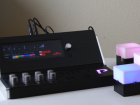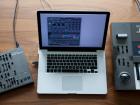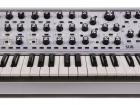9 Worst Things You Can do to a Vintage Synth

Post date:
In terms of audio, there is almost nothing that can’t be done with a synthesizer. The ability to manipulate electricity by a machine and turn it into sound has been a revolution for the music industry. However, there are also a couple of things that simply shouldn’t be done to a synth - especially not a vintage one. As incredible as they are, synthesizers are very vulnerable to mishaps, whether through accidents or ignorance. This is why we think that anyone who cares about the condition of their prized synthesizers should pay close attention to the misfortune that befell some of our members and avoid making the same mistakes.
Let It Ride The Lightning
No matter how unlikely the chances are of something getting struck by lightning, it does happen, which is why surge suppressors are a must. Meatballfulton learned this lesson the hard way when a bolt of lightning hit a power line on their street during a thunderstorm. This resulted in the surge traveling down the line and frying the SQ-80's motherboard.
Give It An Acetone Bath
It’s normal to want your synth to look good, so when forum user Yekuku noticed some yellowing on the white button caps of his Juno 60, he decided some cleaning is in order. Unfortunately, the method of choice was a quick dip in acetone for the button caps. Instead of becoming cleaner, the caps started to wrinkle instead. Yekuku eventually got them back in operational condition, but it took two days of sanding to accomplish.
Chip Away At Its Sockets
When a MemoryMoog produces smoke instead of sound when turned on, you can bet that something is very wrong. In Garranimal's case, the reason for the smoke was a curtis chip that he placed the wrong way in a socket. A replacement chip cost about $50 at the time, but served as a valuable lesson to pay more attention to the correct orientation of chips.
Turn It Into A Flamethrower
Smoke is bad, but when it comes to synthesizers, flames are even worse. Fortunately for UpTop, the flame was shooting out of their wall socket and not the JP-8000, but it still resulted in a loss of RAM and D/A converter for the JP. This impressive feat was accomplished by winding speaker cable around the ground dongle on the back of the Kaoss Pad through which the JP-8000 was running and then sticking it into the ground hole at the wall outlet. The purpose was to reduce ground noise while recording, which worked, until a strand of wire came loose and sprang up to the hot side of the outlet. While the Kaoss Pad survived the ensuing pyrotechnic display, the JP-8000, which was plugged into the same wall socket, was not as fortunate.
Probe It The Wrong Way
Sparks is another feature that can be added, along with smoke and flames, to the “things Synthesizers shouldn’t do” list. ApolloBoy managed to produce a nice big blue spark when trying to get a test probe on one of the voltage header pins of a PSU board. The purpose was simply to do a recalibration after a recap, but the probe slipped and shorted a couple of pins, which fried the 7815 in the Jupiter-4. At least the 7815 was fairly easy to replace and the errant probe didn’t cause any other damage.
Misidentify Its Ports
All that forum user Ats wanted to do was plug a 25 pin SCSI port ZIP drive into his Kurzweil K2500. Unfortunately, the smell of smoke and LCD going “wacky” when he turned the synth on was his first clue that something went a little awry during the process. It turns out that the zip drive actually had a parallel port, which didn’t react so well with the SCSI port. Thankfully the synth continued to work, but its SCSI capability was gone for good.
Give It Too Much Power
Synthesizers need electricity to operate, but when it gets too much bad things can happen, such as it saying “pweeeeeoooooooooo” and dying. This is what happened to the SQ-80 that Bitexion got from Japan and then plugged in at home in Norway using a normal cable. The problem is that Japan uses 100V power and Norway 240V, which would explain the swansong of the synth. The story does have a happy ending though, as it was only the main fuse that blew and, after replacing it and getting a 110-240V converter, Bitexion was able to coax it back to life.
Leave It On For Two Weeks Straight
It turns out that leaving your equipment on for too long can have a negative impact on their performance as KidVSChemical found out to his dismay. The equipment in question was a Poly-800 which, after accidentally being left on for two weeks straight, was left with oscillator 1 only making white noise sounds. This is great for putting a baby to sleep, but not so great if you plan on making music.
Store It Below A Rickety Wall Shelf
When not using your synthesizer it is usually a good idea to store it somewhere safe. Below a rickety shelf that is loaded with books, cables, software boxes and CDs is definitely not safe, as AtomicShadow can attest. Their shelf came crashing down in the early hours of the morning, clipping the Alesis Fusion in the process, knocking the keyboard stand over and breaking three keys. The keys could be replaced, but the damage could have been much worse, which is why Atomic Shadow invested in some sturdy metal lab cabinets as well.






